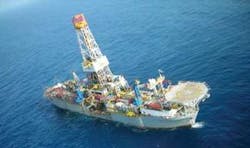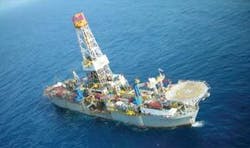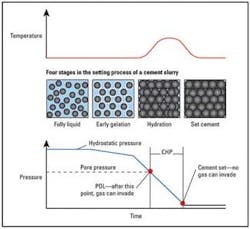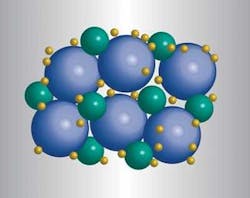Cementing casing in deepwater a balancing act
Amir Salehpour - Schlumberger
Deepwaters challenge drilling operations both technically and logistically. Often there is a narrow margin between pore pressure and fracture pressure, so drilling fluids and cement slurries must maintain a critical balance to avoid taking a kick on one hand or losing circulation on the other. If formations are weak and unstable, there is a good chance for shallow water flow. One tricky challenge is to successfully set surface casing—a task that is typically straightforward in environments other than deepwater.
Unstable formations and deepwater conditions pose a formidable challenge to cementing. Not only must the cement slurry stay within the narrow pressure margin, but it also must set up fast and hard. The usually low temperatures of deepwater tend to extend cement hydration time, delaying its ability to stop gas migration and to build the compressive strength necessary to support the casing and to achieve zonal isolation.
A complex problem
Exploring offshore Pakistan with the Transocean drillshipDiscoverer 534, Shell engineers faced the normal challenges of deepwater well construction. Among these was limited deck space aboard the floating rig. A large percentage of the variable deck load capacity was taken up by the 4,300 ft (1,311 m) of marine riser in the water plus spare joints on the riser rack. The rig also was loaded with the extra equipment needed to support well construction far from the nearest supply base. Shell’s first deepwater exploration well was the Anne-AX, in block 2365-1.
When narrow pressure margins and weak formation strengths are encountered, the usual procedure is to use foamed cement to reduce the hydrostatic pressure of the slurry and to speed the hydration process. Foaming requires special equipment but the rig did not have spare room for that hardware. The challenge was to design a cement slurry for use on a drillship with limited deck space and bulk cement capacity to achieve the required compressive strength quickly at low temperatures, and to ensure complete coverage and zonal isolation in deepwater.
By taking a methodical, engineered approach, Shell designed a solution to each of the factors that challenged successful installation of surface casing. In this case, gas migration was not thought to be a risk, but critical hydration time in cold temperatures was. Using design software accounts for these factors and leads to the least risky alternative. Yet it is not a “black box” approach. Each step can be analyzed and alternatives can be simulated. Test samples can be mixed, cast, and tested in the lab to ensure the cement’s actual physical properties match those promised by the design.
Since foamed cement could not be used, Shell engineers selected DeepCRETE cement slurry and DeepCEM deepwater additives from Schlumberger to cement the 13 3/8-in (44-cm) surface string in the 17 ½-in (44.5-cm) borehole, taking into account the requirement for 150% excess volume as a safety factor against borehole washouts or losses. A total of 482 bbl of lead cement and 216 bbl of tail were mobilized to the rig. One advantage of the selected cement formulation is that it can be blended onshore, then transferred dry to the rig. By design, no fresh water was required. Both the lead and the tail were mixed with seawater on the fly as they were pumped. As a result, fewer personnel and little additional equipment were required.
The 12.5 lbm/gal (1,501 kg/m3) slurry was pumped as the lead cement, and full returns were achieved to the seabed. Despite the cold, the cement set quickly as designed and built compressive strength to 1,500 psi in 24 hours. Waiting-on-cement time was reduced to 10 hours, which was less than expected. The rig drilled out hard cement, and a leak-off test conducted at the casing shoe withstood 10.9 lbm/gal (1,309 kg/m3) equivalent mud weight, 0.7 lbm/gal more than needed to allow safe drilling.
Planning to succeed
Software applications help engineers choose the correct formulation to match specific well situations and operational constraints. For example, gas migration can ruin a cement job and many different scenarios can cause it. Accordingly, a systematic combination of programs helps choose the best solution from a portfolio of additives. The programs reside in a gas migration control engineering suite that includes gas migration advisor and cement hydration analyzer programs. Designed to evaluate gas migration severity based on well geometry, fluid placement, and reservoir properties, the gas migration advisor computes a composite risk based on three parameters: the pressure decay limit (PDL), the point at which the hydrostatic pressure of the setting cement matches reservoir pressure or pore pressure. At this point, formation gas can invade. The mud removal risk is associated with the degree of cement coverage and the possibility that mud might be left on the wellbore walls above or below the gas zone. The formation productivity risk is based on the formation’s capability of delivering a significant volume of gas during the cement setting time. Additives cannot mitigate poor mud removal, but if the advisor indicates sufficient risk, a pre-treatment engineered using WellClean II software can be run.
The composite answers of the gas migration advisor and cement hydration analyzer programs determine the additives most likely to achieve desired objectives. A customized solution can be designed for every well.
Cement design
While additives can enhance cement hydration time or block gas migration, the overall success of the job depends on the basic cement structure. The cement is engineered specifically for deep ocean environments. Near-freezing temperatures, gas hydrates, unstable flowing sands, and lost circulation are challenges that must be addressed by cement design.
It is worthwhile to understand how cement turns from a near-liquid slurry to a solid, high-strength impervious mass. The key is to make the critical hydration period (CHP) as quick as possible. This limits the time for gas to invade. Gas blocking additives can reduce gas influx even further.
Another parameter to hasten the cement slurry’s setting time is particle-size distribution. This involves filling the void spaces among the cement grains with smaller grains, then filling the void spaces among those with even smaller particles. The smaller particles are engineered to contribute to both the slurry and the set-cement properties, leaving water as a reactant and carrying agent, and retaining the cement properties most valued in deepwater. These properties include density disconnected from rheology, lower permeability, higher and faster compressive strength, improved mechanical durability, improved injectability for squeeze treatments, and better logistics. By filling the void space, the amount of liquid is reduced and slurry weight can be controlled better. With a higher solids-to-liquid ratio, setting time is reduced and compressive strength is enhanced. Among the benefits of fast-setting cement are lower rig costs due to less time waiting-on-cement, early protection of casing from corrosive fluids, and risk mitigation of shallow water flows. A range of slurry densities can be obtained with minor changes in the dry blend composition because the addition of smaller particles to fill the void spaces does not increase the mix volume.
Offshore Pakistan, this feature proved valuable to Shell because engineers could plan the volume of cement in advance to fit on the available deck space onDiscoverer 534. Later, if desired, density could be changed without adding volume.



